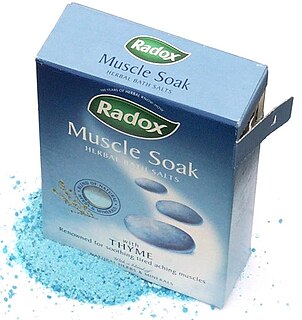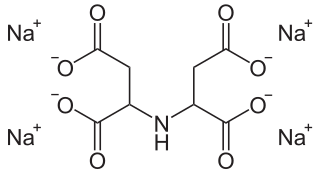
In chemistry, a salt is an ionic compound that can be formed by the neutralization reaction of an acid and a base. Salts are composed of related numbers of cations and anions so that the product is electrically neutral. These component ions can be inorganic, such as chloride (Cl−), or organic, such as acetate ; and can be monatomic, such as fluoride (F−), or polyatomic, such as sulfate.

Soap is the term for a salt of a fatty acid or for a variety of cleansing and lubricating products produced from such a substance. Household uses for soaps include washing, bathing, and other types of housekeeping, where soaps act as surfactants, emulsifying oils to enable them to be carried away by water. In industry, they are used as thickeners, components of some lubricants, and precursors to catalysts.
Saponification is a process that involves conversion of fat or oil into soap and alcohol by the action of heat in the presence of aqueous alkali (e.g. NaOH). Soaps are salts of fatty acids whereas fatty acids are saturated monocarboxylic acids that have long carbon chains (at least 10) e.g. CH3(CH2)14COOH.
The common-ion effect states that in a chemical solution in which several species reversibly associate with each other by an equilibrium process, increasing the concentration of any one of its dissociated components by adding another chemical that also contains it will cause an increased amount of association. This result is a consequence of Le Chatelier's principle for the equilibrium reaction of the association/dissociation. The effect is commonly seen as an effect on the solubility of salts and other weak electrolytes. Adding an additional amount of one of the ions of the salt generally leads to increased precipitation of the salt, which reduces the concentration of both ions of the salt until the solubility equilibrium is reached. The effect is based on the fact that both the original salt and the other added chemical have one ion in common with each other.
Palmitic acid, or hexadecanoic acid in IUPAC nomenclature, is the most common saturated fatty acid found in animals, plants and microorganisms. Its chemical formula is CH3(CH2)14COOH, and its C:D is 16:0. As its name indicates, it is a major component of the oil from the fruit of oil palms (palm oil). Palmitic acid can also be found in meats, cheeses, butter, and other dairy products. Palmitates are the salts and esters of palmitic acid. The palmitate anion is the observed form of palmitic acid at physiologic pH (7.4).

Niter, or nitre (chiefly British), is the mineral form of potassium nitrate, KNO3, also known as saltpeter or saltpetre. Historically, the term niter was not well differentiated from natron, both of which have been very vaguely defined but generally refer to compounds of sodium or potassium joined with carbonate or nitrate ions.
Lauric acid or systematically, dodecanoic acid, is a saturated fatty acid with a 12-carbon atom chain, thus having many properties of medium-chain fatty acids, is a bright white, powdery solid with a faint odor of bay oil or soap. The salts and esters of lauric acid are known as laurates.
Resin acid refers to mixtures of several related carboxylic acids, primarily abietic acid, found in tree resins. Nearly all resin acids have the same basic skeleton: three fused rings having the empirical formula C19H29COOH. Resin acids are tacky, yellowish gums that are water-insoluble. They are used to produce soaps for diverse applications, but their use is being displaced increasingly by synthetic acids such as 2-ethylhexanoic acid or petroleum-derived naphthenic acids.
Resin soap is a mix of salts of resin acids. It is a yellow gelatinous pasty soap with use in bleaching and cleaning and as a compound of some varnishes. It also finds use in rubber industry.
Lithium soap, often loosely referred to as "lithium grease" or "white lithium", is a soap that is a lithium derivative. Lithium soaps are primarily used as components of certain lubricant greases.

Bath salts are water-soluble, pulverised minerals that are added to water to be used for bathing. They are said to improve cleaning, enhance the enjoyment of bathing, and serve as a vehicle for cosmetic agents. Bath salts have been developed which mimic the properties of natural mineral baths or hot springs. Some bath salts contain glycerine so the product will act as an emollient, humectant or lubricant. Fragrances and colors are often added to bath salts; the fragrances are used to increase users' enjoyment of the bathing experience.
Phosphate coatings are used on steel parts for corrosion resistance, lubricity, or as a foundation for subsequent coatings or painting. It serves as a conversion coating in which a dilute solution of phosphoric acid and phosphate salts is applied via spraying or immersion and chemically reacts with the surface of the part being coated to form a layer of insoluble, crystalline phosphates. Phosphate conversion coatings can also be used on aluminium, zinc, cadmium, silver and tin.
Oleochemistry is the study of vegetable oils and animal oils and fats, and oleochemicals derived from these fats and oils or from petrochemical feedstocks through physico-chemical modifications or transformation. First used in the making of soaps, oleochemistry is now part of our daily lives where it is found in a wide variety of sectors like food, cosmetics, pharmaceutical and industrial. The resulting product can be called Oleochemicals. They are analogous to petrochemicals derived from petroleum.
Lithium 12-hydroxystearate is a chemical compound classified as a lithium soap. In chemistry, "soap" refers to salts of fatty acids. Lithium 12-hydroxystearate is a white solid. Lithium soaps are key component of many lubricating greases.
Saltwater soap, also called sailors' soap, is a potassium-based soap for use with seawater. Inexpensive common regular commercial soap will not lather or dissolve in seawater due to high levels of sodium chloride in the water. Similarly, common soap does not work as well as potassium-based soap in hard water where calcium replaces the sodium, making residual insoluble "scum" due to the insolubility of the soap residue. To be an effective cleaning agent, soap must be able to dissolve in water.
Sodium salt are salt composed of sodium cation and the conjugate base anion of some inorganic or organic acid. They can be formed by the neutralization of the acid with sodium hydroxide.
Isethionates are esters of long-chain aliphatic carboxylic acids (C8 – C18) with isethionic acid (2-hydroxyethanesulfonic acid) or salts thereof, such as ammonium isethionate or sodium isethionate. They are also referred to as acyl isethionates or acyloxyethanesulfonates.

Tetrasodiumiminodisuccinate is a sodium salt of iminodisuccinic acid, also referred to as N-(1,2-dicarboxyethyl)aspartic acid.







